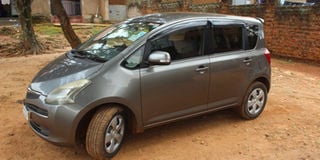The Toyota Ractis is spacious, comfortable

The Ractis operates on basic technology, making it easy to diagnose and repair its mechanical faults . PHOTOs/Roland D. Nasasira
What you need to know:
Although a subcompact vehicle by make, with front and rear edges almost similar to those of the Spacio, the Toyota Ractis edges over the Spacio in terms of interior spaciousness and driving comfort.
“I love the Toyota Ractis because it is a simple car. Since I bought it in 2020, I have not carried out any major repairs other than normal service. I visit the garage twice or thrice a year and during each of these times, I spend approximately Shs150,000. The kind of service I do depends on what needs to be fixed. my car rarely breaks down, especially since I mostly use it for urban drives,” says Ritah Ninsiima when asked about why she bought the Toyota Ractis as opposed to any other car.
Technically, Ninsiima’s experience with the Toyota Ractis best defines a low consumption, cheap and affordable car in terms of maintenance and cost. This makes it suitable for first time motorists or those looking for a car with similar features.
“I love music when driving and among the small cars I have had a chance to test drive, the Ractis has better amplified speakers that distribute sound and output evenly,” she adds.
Engine
Running on a 1500cc petrol engine, the Ractis also fits in the bracket of one of the compact cars with a low fuel consumption rate, given the fact that fuel prices have been maintained at approximately Shs5,400 per litre amid challenging economic times. Other cars with similar sizes that could rival the Ractis include the Toyota Spacio, Raum, Sienta, Passo, Passo Sette, Toyota Vitz, Auris, Allion and the Toyota Allex, among others.
To fill its tank, Ninsiima spends Shs210,000 and uses between Shs300,000 to Shs400,000 on fuel in a month of weekly commutes from her home Kireka to Ntinda, with the exception of weekends when she does not work.
Apart from Ninsiima, Leah Nansamba has also driven the Ractis for two years. In this time, she has found the Ractis to have basic technology, meaning it can easily be repaired by any knowledgeable mechanic as long as they understand the mechanical fault.
For instance, in mid-2023 during a road trip in Mbale City in eastern Uganda, the car abruptly started heating up, leaving her stranded by the roadside with no idea of what to do next.
“I looked for a mechanic in Mbale and when they inspected the car, one of the pipes that transports water to the radiator for cooling had become brittle and broken. It was replaced within a short time, enbling me to continue with the journey,” Nansamba says.
On the highway, the Ractis covers approximately 15km per litre of fuel.
Performance
Ninsiima says while test driving the Ractis on the Entebbe expressway, she discovered that it is not a high performance or sporty car but a basic car to move you from one point to another.
However, in terms of performance, it picks up speed from zero to the 100km/hr mark in 20 seconds. This, however, depends on the weight of your acceleration foot because it has the engine power to reach the 100km/hr mark in a shorter time.
Unfortunately, at high speeds, it tends to become light, making it unsafe to drive above certain speeds. The lighter it becomes with increase in speed, the easier and faster it will veer off the road.
On marrum roads, the Ractis has a ground clearance suitable for driving safely on rough roads but is raised enough to manoeuvre through Kampala’s potholes.
Interior
Ninsiima says the Ractis does not have modern features such as heated seats. It has basic features such as a 12-inch smart screen and basic safety elements such as three-point seatbelts. It also has ample legroom for the driver and co-driver and can accommodate motorists and passengers of all heights because of its well raised roof.
About the Ractis
According to sbtjapan, an online portal, the car was introduced in 2005 as the successor of Toyota Yaris Verso. The name Toyota Ractis is derived from three basic words which are run, activity and space. The portal says the car has offered a lot of space and features and has made huge markets all over the world. The car is divided into two generations where the first generation was sold in the market from 2005 to 2010 and the production of second generation started in 2010.
“You can purchase this car in manual or automatic transmission. With different engine sizes, you can choose the engine size that fits your requirements. If you want your Toyota Ractis to be fuel efficient, then you should go for the 1.3L engine and if you want a powerful engine, then you should go for 1.5L engine,” the portal says, adding that the length of this car is 158 inches while the width is 67 inches. The overall weight is 1,475 kg.
FAQs
How safe is Toyota Ractis?
Toyota is preferred since it is safe and dependable. Toyota is tireless in pursuing higher quality, safety and productivity with each new unit. Toyota Ractis is a vehicle that is true to its market offer in terms of build quality and a variety of safety features.
What is the storage capacity of Toyota Ractis?
With a boot capacity of 429 litres, the Toyota Ractis ranks strongly in this area. When more room is required, the rear seats may be folded flat to form a big boot.




